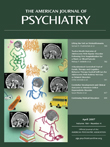Neural Responses to Happy Facial Expressions in Major Depression Following Antidepressant Treatment
Abstract
Objective: Processing affective facial expressions is an important component of interpersonal relationships. However, depressed patients show impairments in this system. The present study investigated the neural correlates of implicit processing of happy facial expressions in depression and identified regions affected by antidepressant therapy. Method: Two groups of subjects participated in a prospective study with functional magnetic resonance imaging (fMRI). The patients were 19 medication-free subjects (mean age, 43.2 years) with major depression, acute depressive episode, unipolar subtype. The comparison group contained 19 matched healthy volunteers (mean age, 42.8 years). Both groups underwent fMRI scans at baseline (week 0) and at 8 weeks. Following the baseline scan, the patients received treatment with fluoxetine, 20 mg daily. The fMRI task was implicit affect recognition with standard facial stimuli morphed to display varying intensities of happiness. The fMRI data were analyzed to estimate the average activation (overall capacity) and differential response to variable intensity (dynamic range) in brain systems involved in processing facial affect. Results: An attenuated dynamic range of response in limbic-subcortical and extrastriate visual regions was evident in the depressed patients, relative to the comparison subjects. The attenuated extrastriate cortical activation at baseline was increased following antidepressant treatment, and symptomatic improvement was associated with greater overall capacity in the hippocampal and extrastriate regions. Conclusions: Impairments in the neural processing of happy facial expressions in depression were evident in the core regions of affective facial processing, which were reversed following treatment. These data complement the neural effects observed with negative affective stimuli.



